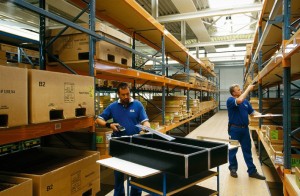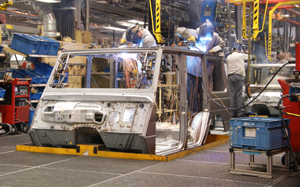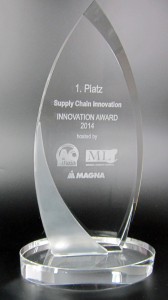Magna puts more in providers’ hands
 As tier suppliers take over more content and engineering in the automotive supply chain, the scope for logistics providers to increase their services and value to companies such as Magna is growing.
As tier suppliers take over more content and engineering in the automotive supply chain, the scope for logistics providers to increase their services and value to companies such as Magna is growing.
For decades, the automotive supply chain has seen considerable product development and engineering spread from OEMs to the supply base. Carmakers are increasingly buying modules from tier suppliers, whether climate and exhaust systems, seats or, more recently, parking assist and infotainment technology. The average purchasing value of a vehicle attributed to suppliers has reached 65%, and is expected to surpass 70% in the coming years.
With this rising demand, tier suppliers are handling a larger variety of part numbers, while simultaneously serving customers across more global locations and with shorter model life cycles. According to Magna’s European logistics and purchasing management, this has been a recipe for more sophisticated supply chain management, and in particular the need for a stronger focus on standards, tracking and planning.
For example, increasingly complex flows and data exchange are driving the need for process coherence. Thanks to growing part numbers and supply points, Magna has seen a huge rise in data exchange. In Europe, the company sent around 1.17m EDI messages in 2008; in 2013, this had grown to 200,000 per week. Without effective, standard systems to coordinate this, the risk of miscommunication and disruption increases.
Klaus Iffland, vice-president of global purchasing and logistics at Magna International Europe, points out that, with an increasing number of vehicles built on global platforms, carmakers want standardised processes, including for logistics. “OEMs don’t want three different systems with separate IT structures and payment processes in each region from tier suppliers, since they are increasingly building models and platforms globally,” he says. “They want one company that can operate with a global footprint.”

The result is that logistics need to be coordinated across borders and operations, including material movements as well as freight tracking and packaging optimisation. These are opportunities for logistics providers to play a stronger role in a tier supplier like Magna’s global operations. “We are looking to build stronger relationships across the supply chain,” says Iffland. “OEMs are getting us [tier ones] involved very early in new programmes and vehicle launches, and so we want to work more strategically with our own [tier two] suppliers and with logistics providers.”
Central and periphery strengths
Magna builds commodities that range from powertrain systems to plastic interior parts or complete vehicles, with sprawling supply chains that are not always directly related to one another. In Europe alone, Magna has more than 120 plants; logistics decisions could be made by individual plants or separate divisions, while Magna Logistics Europe (MLE), based in Graz, Austria, supports activities across facilities, including bundled transport bids, engineering and packaging (read more here).
In many ways, MLE is unique at Magna globally as a management entity. While it is not entirely a central logistics function, MLE is responsible for or involved in a growing number of bids and common operations across Europe (although larger plants, such as Magna Steyr’s contract manufacturing operations in Graz, or some powertrain facilities, procure the majority of their own freight). Jörg Blechinger, director of MLE, wants the division to act as an integrator, pulling together innovation from across the company. In Europe, for example, there are expert teams in packaging, transport management, supply chain engineering, along with information and material flow.
“It makes sense to centralise certain processes, and to leave others to plants or divisions,” says Blechinger. “We would never interfere with the operational processes of a plant, but it makes sense to procure or engineer the common supply network.”
There are cases where MLE has a stronger control over logistics. A good example is for Russia, for which Magna consolidates supplies in Germany and central Europe – and in some cases from as far afield as Mexico – which it then moves to Russian plants in full truckloads. It’s a supply chain that MLE designed and procured centrally, using packaging and IT tools to track material flow, says Blechinger.
However, both Blechinger and Iffland are careful to clarify that they are not seeking deeper centralisation of logistics control and procurement across the company. “The decentralised principles of Magna are key success factors,” adds Iffland. “Plants are speedy, flexible and have strong leaders. It is our job in logistics and purchasing to support this decentralisation with stronger systems, processes and standards.”
 Magna is trying to share best practices across divisions and regions, including the establishment of a global packaging standards team
Magna is trying to share best practices across divisions and regions, including the establishment of a global packaging standards team
Elsewhere, Magna has extended what had previously been regional divisions into more global organisations. Interiors and exteriors became global groups earlier in 2014, with purchasing and logistics procurement switching its management to meet their needs. “We have formed global sourcing committees, for example, to fulfil our customers’ global requirements,” says Iffland.
Magna has also done more to develop committees between its main purchasing regions in Europe, North America and Asia Pacific. Each of those regions has a tremendous variation of products, plants and services, but Iffland says Magna is doing more to implement supplier standardisation, ratings and controls. “For logistics, there are people responsible for cross-group projects and we are trying to better link those across regions,” he says.
Going for world-class logistics
 Under Iffland, Magna has better integrated purchasing and logistics for sourcing and manufacturing decisions
Under Iffland, Magna has better integrated purchasing and logistics for sourcing and manufacturing decisionsPart of the drive to improve standards and processes is the company’s commitment to ‘World-Class Manufacturing’ (WCM) and the logistics principles that accompany it. These include lean principles, early involvement of logistics and other processes in a product’s engineering and planning phase, together with a wider standardisation in systems and packaging. “Standardisation in a decentralised world such as Magna’s is critical,” says Iffland. “That is what we are working on as part of WCM in areas such as packaging, planning and data management. It starts with the early planning phases and ends with execution after launch.”
For Iffland, part of this process began soon after he took on his current role and combined logistics with purchasing to ensure total costs were considered more carefully in sourcing and manufacturing decisions. “We’ve tried to create synergies between logistics and purchasing, and to make sure that decisions and impacts for logistics providers were part of the sourcing procedure,” he says.
In some cases, this improved visibility means smarter sourcing decisions, such as avoiding cheap parts from Asia to supply Europe that end up costing more after freight and duty costs are considered. However, both Blechinger and Iffland see the global supply chain as inevitable for Magna, even as localisation remains critical for supply chain efficacy.
“We don’t observe a trend in sourcing shifting from one location to another; it’s about being competitive to OEMs whether they have plants in southern Germany, eastern Europe or Latin America,” says Iffland. “When Audi decides to produce the next vehicle in Mexico, it asks its top suppliers to follow them. Having a global footprint can be an advantage, as we already have in North America. But it is also a case of following manufacturers to new locations.”
Blechinger points out that, in many cases, the transition to new production locations means increased shipping from an established supply base, such as for Russia, as well as growing locations such as Mexico and in Asia.
Know me to serve me
A strategic view of logistics and the supply chain is central to Magna’s purchasing management, particularly for serving global customers. Both Iffland and Blechinger want to see a similar approach from logistics providers. “If we are working on strategic programmes, then I expect our LSPs to tell us where they have strengths or might be building up systems or services in those areas,” says Blechinger. “I want to get into such strategic discussions early and often in our programmes.”
Blechinger points to WCM, people development and innovation as the three “pillars” of Magna’s logistics management. “I expect to see our service providers working intensively on lean processes, along with investment in innovation such as data flow and smartphone technology,” he says. “You see that younger people today are using technology in a completely different way to the way we use it. So what does that mean for a logistics employee in 2030, or even 2050?”
 "If we are working on strategic programmes, then I expect our LSPs to tell us where they have strengths or might be building up systems or services in those areas. I want to get into such strategic discussions early and often"
"If we are working on strategic programmes, then I expect our LSPs to tell us where they have strengths or might be building up systems or services in those areas. I want to get into such strategic discussions early and often"
- Jörg Blechinger, Magna International
Such questions are difficult for any provider to answer. But the fact that Magna wants such a strategic view for logistics demonstrates its importance within the company, and the potential for providers to grow with Magna, as well as to prepare for economic and supply chain risk. Dealing with the market fallout in Russia is a case in point, as production and shipments to plants decline sharply. Blechinger believes that Magna’s supply chain has been flexible enough to react to drops this year and avoid running empty equipment, but at the same time that it is prepared for recovery in Russia.
“Russia is still an attractive market in the long term, and we have implemented very strong processes there, controlled by online monitoring and very good people,” he says. “The system works and is an example of how logistics can help you follow customer demand in a very efficient way.”
At a fundamental level, Iffland and Blechinger want Magna’s providers to understand their business at least as well as they have to understand their own OEM customers. “LSPs have to follow the market, and be prepared for all of its changes, ups and downs,” says Iffland. “Just as we have to do.”
Jörg Blechinger stresses that standardising IT systems and packaging can make big gains across Magna’s network. It was in that context that Magna Logistics Europe awarded companies this past autumn for innovation and sustainability solutions. The awards, given in conjunction with AutoCluster Styria, which represents 180 suppliers and manufacturers in the Austrian state of Styria, had a strong focus on packaging and IT solutions. The winners included an RFID tracking device for air freight by TAGnology, while a sustainability award was given to Virtual Vehicle for a system that allows manufacturers to test friction losses for engines. Of the six overall winners, three were related to packaging, with a focus on modular inserts, ease of foldability and lightweight material.
“OEMs are requesting more proof of sustainability from their suppliers and so we have to follow this trend,” Blechinger says.
 Supply Chain Innovation winners
Supply Chain Innovation winners
1st TAGnology – RFID tracking in air freight
2nd DS Smith – lightweight, easy-to-fold packaging
3rd Verath – ‘flipbox’ packaging system adjustable for many different inserts
Clean Mobility Innovation winners
1st Virtual Vehicle – FRIDA virtual friction testing system
2nd Secar Technologie – LiteCon cargo container
3rd DB Schenker – hydrogen-cell forklift trucks
Click here for more on Magna’s innovation awards.





